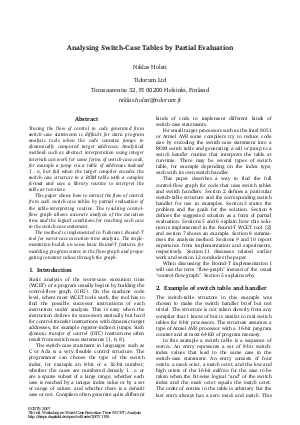Analysing Switch-Case Tables by Partial Evaluation
Author Niklas Holsti
-
Part of:
Volume:
7th International Workshop on Worst-Case Execution Time Analysis (WCET'07) (WCET 2007)
Part of: Series: Open Access Series in Informatics (OASIcs)
Part of: Conference: Workshop on Worst-Case Execution Time Analysis (WCET) - License:
 Creative Commons Attribution-NonCommercial-NoDerivs 3.0 Unported license
Creative Commons Attribution-NonCommercial-NoDerivs 3.0 Unported license
- Publication Date: 2007-11-13
File

PDF
OASIcs.WCET.2007.1195.pdf
- Filesize: 324 kB
- 8 pages
Document Identifiers
Subject Classification
Keywords
- WCET
- switch-case
- partial evaluation
Metrics
- Access Statistics
-
Total Accesses (updated on a weekly basis)
0Document
0Metadata
Abstract
Tracing the flow of control in code generated from switch-case statements is difficult for static program analysis tools when the code contains jumps to dynamically computed target addresses. Analytical methods such as abstract interpretation using integer intervals can work for some forms of switchcase code, for example a jump via a table of addresses indexed 1 .. n, but fail when the target compiler encodes the switch-case structure in a ROM table with a complex format and uses a library routine to interpret the table at runtime. This paper shows how to extract the flow of control from such switch-case tables by partial evaluation of the table-interpreting routine. The resulting control-flow graph allows accurate analysis of the execution time and the logical conditions for reaching each case in the switch-case statement. The method is implemented in Tidorum's Bound-T tool for worstcase executiontime analysis. The implementation builds on some basic BoundT features for modeling program states in the flowgraph and propagating constant values through the graph.
Cite As Get BibTex
Niklas Holsti. Analysing Switch-Case Tables by Partial Evaluation. In 7th International Workshop on Worst-Case Execution Time Analysis (WCET'07). Open Access Series in Informatics (OASIcs), Volume 6, pp. 1-8, Schloss Dagstuhl – Leibniz-Zentrum für Informatik (2007)
https://doi.org/10.4230/OASIcs.WCET.2007.1195
BibTex
@InProceedings{holsti:OASIcs.WCET.2007.1195,
author = {Holsti, Niklas},
title = {{Analysing Switch-Case Tables by Partial Evaluation}},
booktitle = {7th International Workshop on Worst-Case Execution Time Analysis (WCET'07)},
pages = {1--8},
series = {Open Access Series in Informatics (OASIcs)},
ISBN = {978-3-939897-05-7},
ISSN = {2190-6807},
year = {2007},
volume = {6},
editor = {Rochange, Christine},
publisher = {Schloss Dagstuhl -- Leibniz-Zentrum f{\"u}r Informatik},
address = {Dagstuhl, Germany},
URL = {https://drops.dagstuhl.de/entities/document/10.4230/OASIcs.WCET.2007.1195},
URN = {urn:nbn:de:0030-drops-11954},
doi = {10.4230/OASIcs.WCET.2007.1195},
annote = {Keywords: WCET, switch-case, partial evaluation}
}
